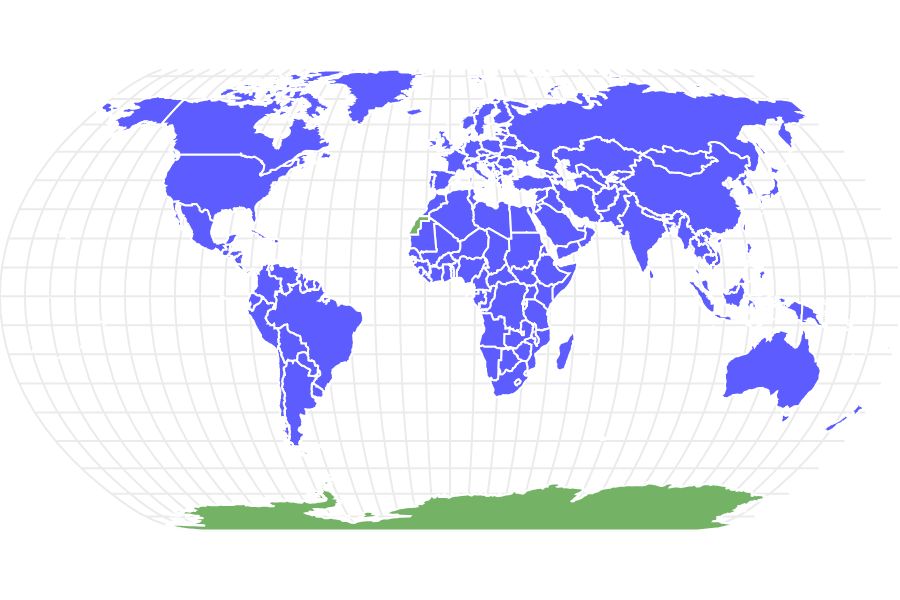Mouse
Found on every continent on Earth!
Advertisement
Mouse Scientific Classification
Read our Complete Guide to Classification of Animals.
Mouse Conservation Status
Mouse Facts
- Average Litter Size
- 6
- Lifestyle
- Solitary
- Favorite Food
- Fruit
- Type
- Mammal
- Slogan
- Found on every continent on Earth!
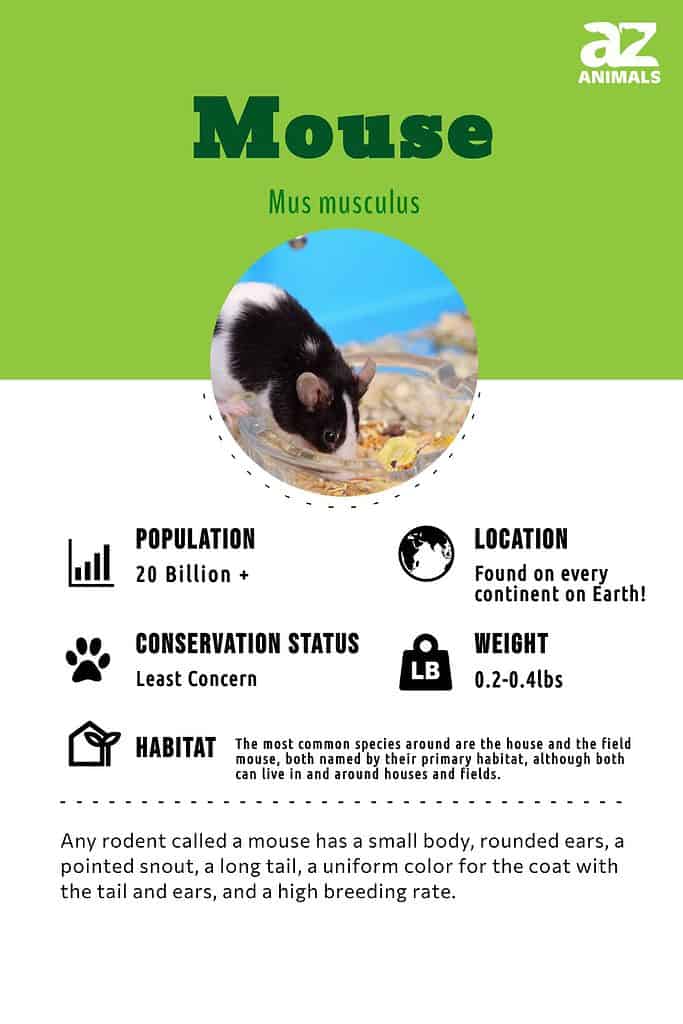
The mouse is a small animal in the order Rodentia, with the most well-known species being the common house mouse.
These mammals all have small bodies, rounded ears, a pointed snout, a long tail, and a high breeding rate. While the field mouse is well-known for invading homes for food and shelter, the house mouse is the most common mammal and household pest in the U.S.
See all of our expert product reviews.
The domesticated house mouse is called a fancy mouse and is one of the most popular rodent pets. Whether this animal is considered a pest or a pet depends on its lifestyle and treatment. Being mammals, mice are also often used for human experimentation for new market products and medicines.
5 Incredible Mouse Facts!
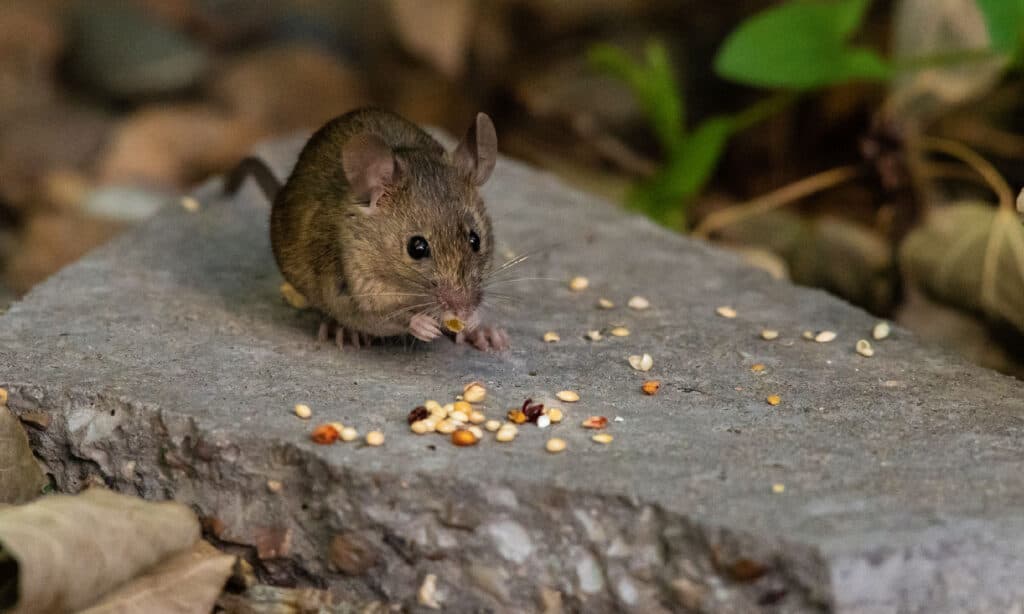
Mice eat up to 20 times a day!
©iStock.com/Víctor Suárez Naranjo
- These animals are gymnasts and escape artists.
- They have big appetites, eating 15-20 times a day.
- They can carry up to 200 human pathogens, including Hantavirus and Salmonella.
- They cannot be potty-trained as pets.
- Females are ready to give birth at 2 months of age and can have up to a dozen babies every 3 weeks, with as many as 150 offspring in one year alone.
For a complete list of incredible mouse facts, make sure to give ‘10 Incredible Mouse Facts‘ a read!
Scientific Name
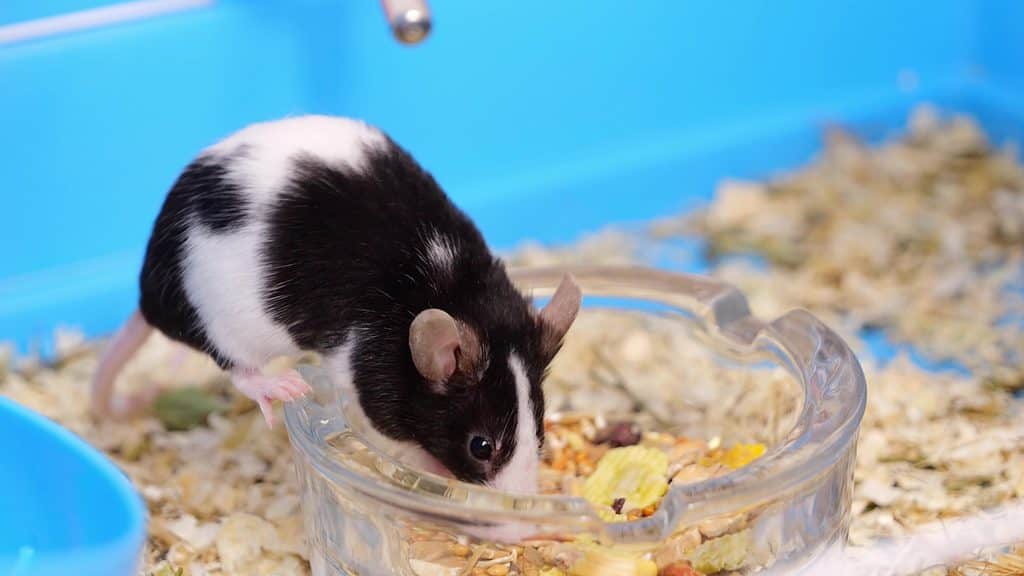
Mice are members of the Rodentia family. Their scientific name is
Health and Entertainment for your Mouse
See all of our expert product reviews.
Mus musculus©myschka79/Shutterstock.com
The mouse is a mammal in the animal kingdom. As a member of the order Rodentia, it is a rodent. All muroid rodents smaller than rats are called mice. True mice and rats are in the family Muridae or the superfamily Muroidea (muroid rodents) which contains 711 species and includes gerbils, hamsters, and voles. Old World mice and rats are in the subfamily Murinae, also called murines, of which there are 519 species.
Typical mice are in the genus Mus, while many species of field mice are in the genus Apodemus. Mus contains 38 species with Mus musculus being the type species. The scientific name of the common house mouse is Mus musculus, and the scientific name of the fancy mouse is Mus musculus domestic.
The difference in the scientific name signifies that it is a domesticated version of the house mouse, having been made docile and bred over many generations specifically for the exhibition. There are 13 subspecies of Mus musculus.
Evolution and Origins
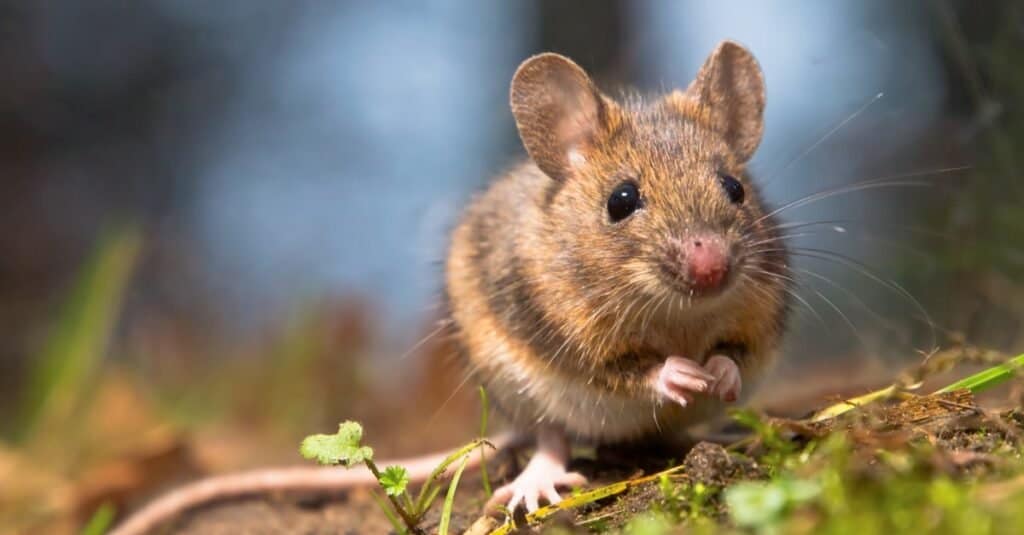
A wildwood mouse sitting on the forest floor. Male mice use their songs to attract a mate.
©iStock.com/CreativeNature_nl
The origin of the mouse and human has been the subject of debate and studies. It is now believed that the mouse lineage diverged from the human somewhere around 75 million years ago. Additionally, the origin of the mouse as the model system for biomedical research dates back to the start of humankind and civilization.
Mice appear to have been derived from the hybridization of two other house mouse groups in China and castanets in Southeast Asia. Studies also suggest that humans and rodents went different paths genetically from a common ancestor about 80 million years ago, with rats and mice evolving between 12 and 24 million years ago.
List of Different Types of Mice
Here is a full list of different mice species found around the world:
- House mouse
- Pachyuromys duprasi
- African pygmy mouse
- Deer Mouse
- Pilliga mouse
- White-footed mouse
- Eurasian harvest mouse
- Blue-gray mouse
- Striped field mouse
- Western harvest mouse
- Sable
- Northern Grasshopper mouse
- Mountain pygmy possum
- Cairo spiny mouse
- Cactus mouse
- Salt marsh harvest mouse
- Oldfield mouse
- Cotton mouse
- Desert dormouse
- California deer mouse
- Shark Bay mouse
- Algerian mouse
- Eastern harvest mouse
- Steppe mouse
- Northwestern deer mouse
- Silky pocket mouse
- Great Basin pocket mouse
- Asiatic long-tailed climbing mouse
- Macedonian mouse
- Flat-haired mouse
- Sheath-tailed mouse
- Olive-backed pocket mouse
- Pemberton’s deer mouse
- Sumatran shrewlike mouse
- Perognathinae
- Luzon Aurora forest mouse
- Columbian Mouse
- Toad mouse
- Luzon giant forest mouse
- Sitka Mouse
Mouse vs. Rat
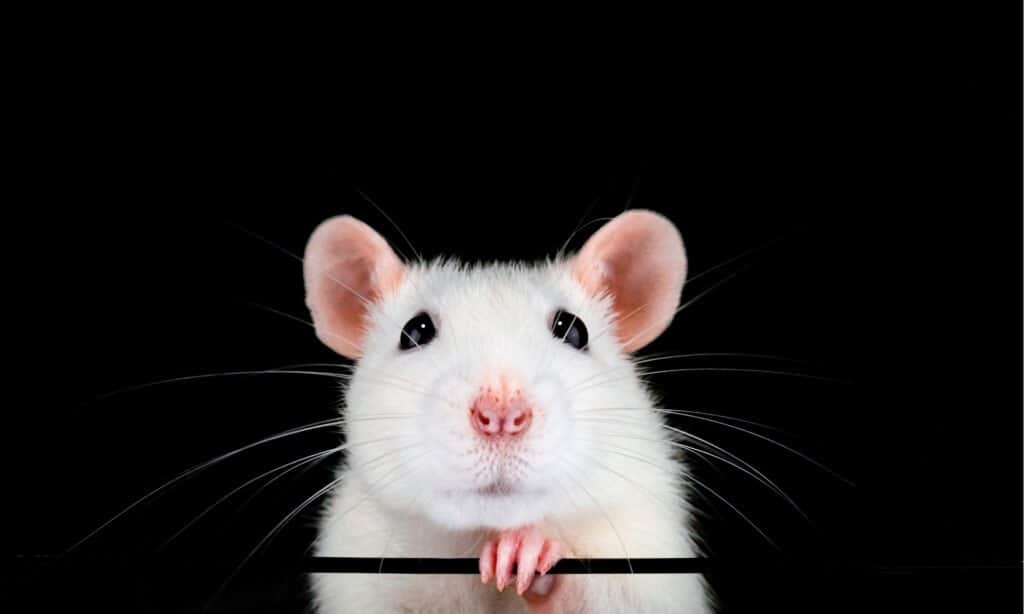
Although mice and rats are both rodents, there are some important differences between the two, especially when choosing one as a pet.
©Linda Bestwick/Shutterstock.com
Although mice and rats are both rodents, there are some important differences between the two, especially when choosing one as a pet. The most important difference is their size. In the wild, rats can reach up to 500 grams (17 1 ⁄ 2 oz) in weight and are always larger than mice. Hence, rats need a significant amount of cage space.
They are also needier than their smaller relatives, demanding human attention and affection. On the other hand, rats can be potty-trained to avoid leaving droppings everywhere when outside the cage.
There are also differences in the types of rodents you can choose from. Unlike rats, mice have tails and ears the same color as their coat, which can come in a huge range of colors. All coat colors and types for the fancy mouse have the same genetics.
When it comes to rats, though, there is a variation. The common pet rat is the fancy rat, which is a standard top-eared Norway rat. The dumbo rat is the same species but with a genetic mutation on chromosome 14 caused by recessive gene dmbo, leading to the “dumbo” name. This mutation results in some physical differences as well as a more docile temperament.
There are also differences when comparing the two as pests. Mice invade the home and cause damage to the structure, whereas rats tend to invade farmhouses, under houses, rubbish dumps, and sewer systems. Both carry diseases as well as parasitic insects that transmit disease, and both can bite people when cornered or near their territory, causing infection.
Rats are smarter, tougher to get rid of, and more damaging to the home, whereas some mice can be handled by the homeowners themselves using mouse traps or poison. Rats can eat mice because of their sheer size advantage.
Appearance
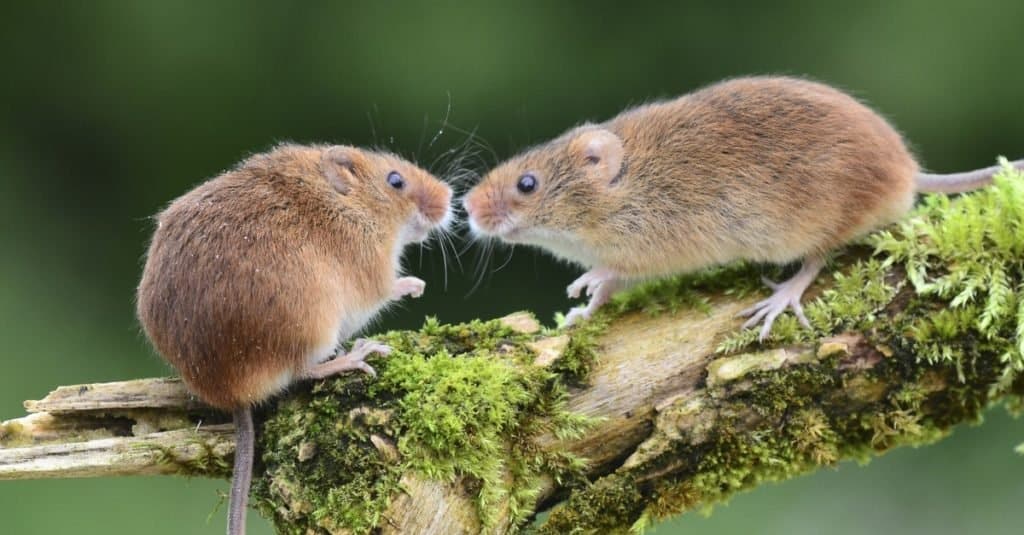
Adult mice weigh about 1 ounce (28 grams) and are about 2.5-3.5 inches (6-8cm) long,
©colin robert varndell/Shutterstock.com
Any rodent called a mouse has a small body, rounded ears, a pointed snout, a long tail, a uniform color for the coat with the tail and ears, and a high breeding rate. Adults weigh about 1 ounce (28 grams) and are about 2.5-3.5 inches (6-8cm) long, excluding the tail. Males are larger than females. The field mouse is slightly larger than the house mouse and has a few other physical differences.
Pet mice can come in several different possible coat colors and coat types: Agouti, self, tan, pointed, patchwork, and marked are general coat colors divided into specific tickings, while hairless, rex/frizzy, satin, longhair, and shorthair are possible coat types. The common standard for the fancy mouse is a white color with a shorthair coat.
Behavior
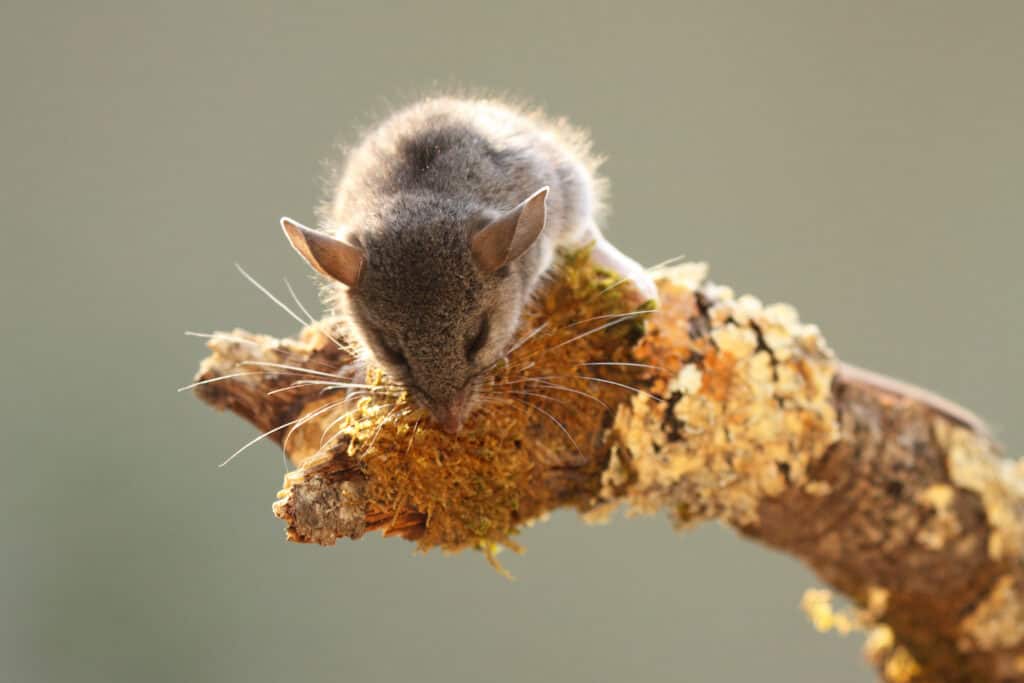
A Jumping Mouse looking down from the end of a perch in California.
©iStock.com/gatito33
Mice and other rodents invade an estimated 21 million homes in the United States each winter. They usually enter homes between October and February in search of food, water, and shelter. They store food near the nests, with food caches usually being within 10 feet of them. Very territorial creatures, they tend to stay within 30 feet of their nests.
Being naturally flexible, they can get into homes through a crack or hole as small as 1/4-inch. They can climb 13 inches up smooth-vertical walls and jump as high as a foot, even while running. Also, they can run 12 feet per second and swim as far as 1/2 mile.
These animals are nocturnal creatures, becoming active at night and constantly searching for new food sources. Being social creatures, they groom themselves and each other. They chase each other for fun or to show dominance during a fight. When happy, they wag their tails. Ears up mean curiosity, while ears down and back mean a defensive posture, especially when combined with stiff body language.
They may stand up to get a closer look or sniff something. Wiggling their whiskers for tactile navigation makes up for their lack of great eyesight. They grind their teeth or chew on wood and other materials to keep their incisors in check. Finally, they enjoy creating nests to sleep in and are natural burrowers.
Habitat
The most common species around are the house and the field mouse (also called deer or wood mouse), both named by their primary habitat, although both can live in and around houses and fields. House mice are native to India, and field mice are native to Europe and northwestern Africa. Another main difference is that field mice are often found in rural areas, whereas house mice take up residence in the buildings of suburbs and cities.
Diet
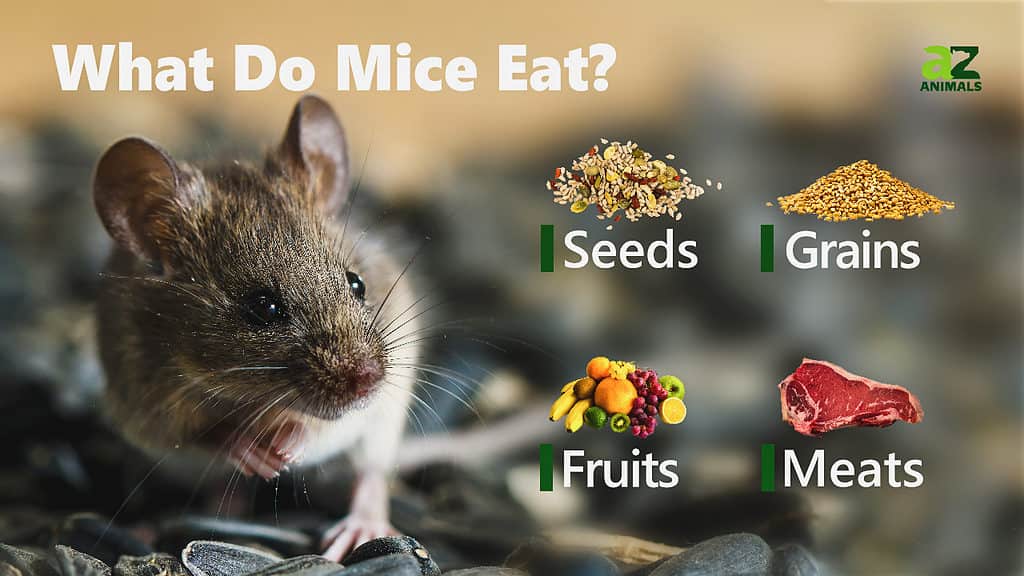
These animals have voracious hunger, eating 15-20 times a day. Their diets in nature are omnivorous but largely herbivorous, consisting of fruits, grains, seeds, corn, oats, roots, leaves, grass, plants, and even tree bark.
They have also adapted to human food scraps and pet food, which often include meat. In captivity, they do well on the full nutrition provided by commercial pellets in combination with a variety of vegetables. Contrary to popular belief, they do not seek out cheese, but will only eat it as a last resort.
Mothers will eat their young during times of famine. Also, some species eat insects. Field mice (also called deer and wood mice) eat beetles, caterpillars, grasshoppers, and leafhoppers.
Predators and Threats
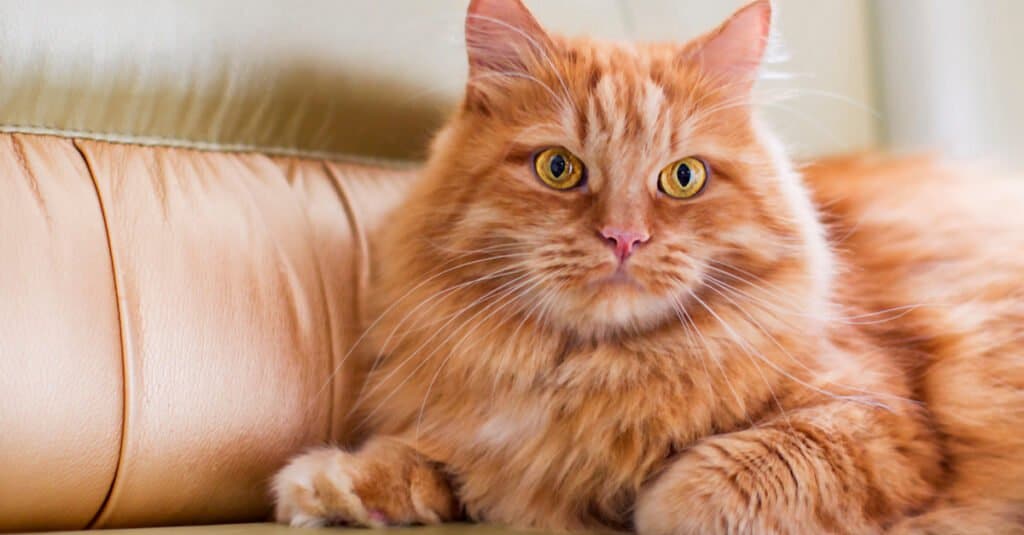
They have a number of larger mammals as predators including cats.
©iStock.com/FediushkinaElena
To avoid predation, these animals keep their activity confined to nighttime and seek covered shelters. They have a number of larger mammals as predators including foxes, snakes, lizards, frogs, weasels, skunks, hawks, owls, tarantulas, dogs, and cats. Humans are consumers of them as well, having eaten them since prehistoric times.
These animals are considered a delicacy in eastern Zambia and northern Malawi as well as in China, where babies are often eaten alive.
Reproduction, Babies, and Lifespan
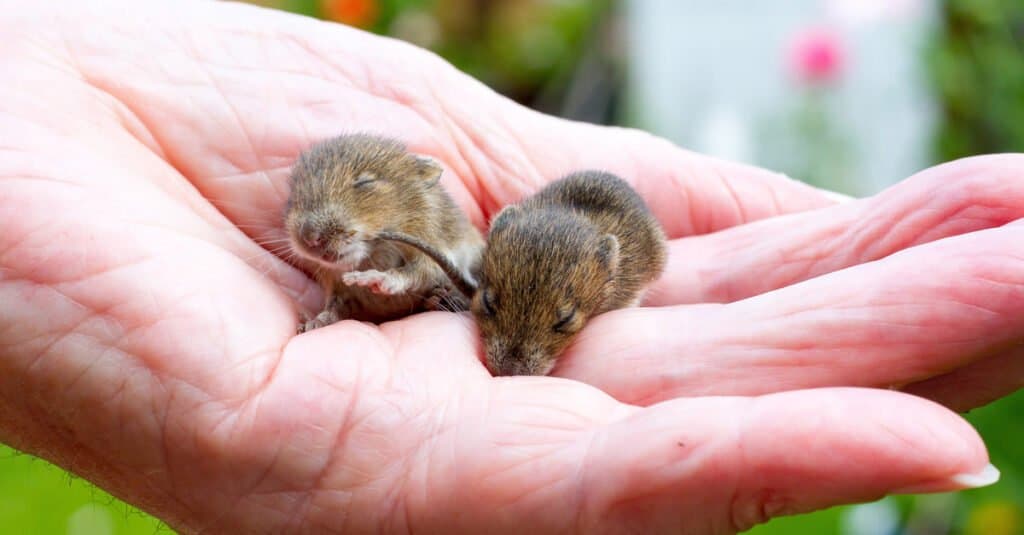
Baby mice
©RICHARD-ASQUITH/Shutterstock.com
Females are ready to give birth at 2 months of age and can become pregnant 24 hours after giving birth. They can have up to a dozen babies every 3 weeks, and as many as 15 litters or 150 babies in one year alone.
When in heat, females dart, jump and vibrate their ears as displays to communicate their willingness to mate. They also emit pheromones, to which males answer by emitting an ultrasonic mating call. Males often have a harem of females in their territorial range.
A baby mouse is called a pup and is born deaf and blind. The average litter size is 5-8 but can be as many as 10-12 pups, with an average of 30-35 babies a year. Gestation is 19-21 days, with up to a week longer if the mother is still nursing another litter.
These animals become sexually mature 35 days after birth. Mothers will sometimes eat babies during famine or in captivity, believed to be due to stress, illness, overcrowding, or being unable to forage outside the nest. The lifespan of mice is 1-2 years in the wild. In captivity, they can live for 3-4 years.
Population
According to the IUCN Red List, the house mouse is of Least Concern. Their populations are stable due to their high breeding rate, the variety in their diet, and their ability to adapt to other habitats.
On the other hand, beach mice are under threat. The Perdido Key beach mouse, in particular, is threatened by habitat loss, introduced predators, and a population decline due to Hurricane Ivan in 2004.
In the Zoo
There are two species you can see at zoos: You can see the cactus mouse at the Lincoln Park Zoo and the Perdido Key beach mouse at the Smithsonian’s National Zoo and the Brevard Zoo.
View all 164 animals that start with MMouse FAQs (Frequently Asked Questions)
Are Mice herbivores, carnivores, or omnivores?
Omnivores. Although their diets are mostly herbivorous, as pests they will eat human food scraps and pet food. They also can and do eat their young, and some mice eat insects.
What Kingdom do Mice belong to?
Mice belong to the Kingdom Animalia.
What class do Mice belong to?
Mice belong to the class Mammalia.
What phylum to Mice belong to?
Mice belong to the phylum Chordata.
What family do Mice belong to?
Mice belong to the family Muridae.
What order do Mice belong to?
Mice belong to the order Rodentia.
What type of covering do Mice have?
Mice are covered in fur.
What genus do Mice belong to?
Mice belong to the genus Mus.
In what type of habitat do Mice live?
Mice live in open fields and woodland areas.
What is the main prey for Mice?
Mice eat fruit, seeds, and grasses.
What are some predators of Mice?
Predators of Mice include birds, cats, foxes, and reptiles.
How many babies do Mice have?
The average number of babies a Mouse has is 6.
What is an interesting fact about Mice?
Mice are found on every continent on Earth!
What is the lifespan of a mouse?
1-2 years in the wild and 3-4 years in captivity.
What's the difference between a mouse and a mole?
There are many differences between mice and moles. Moles live underground, while mice live in fields or households. Mice also enjoy complex social lives, while moles prefer solitude.
What is the difference between a gerbil and a mouse?
The main differences between a gerbil and a mouse are that gerbils have hair on their tails, are native to Mongolia and China, and dig deep burrows in the desert. Mice have hairless tails, are an invasive species worldwide, and generally require a human presence to survive.
What are the key differences between mouse poop and bat poop?
The key differences between mouse poop and bat poop are appearance and characteristics.
How do you keep mice away from your house?
Mice infestations can be a major problem in homes. If you want to keep mice away from your house, follow these five steps as a starting point:
1.) Make sure to keep doors and windows closed.
2.) Use the barrier method – spray blockers like peppermint oil around vulnerable parts of your home.
3.) Shore up your defenses by sealing up any potential holes or gaps.
4.) Eliminate large plants that sit against your home.
5.) Seal up your food and clean up after leftovers.
Are there blind mice?
“Three Blind Mice” is a common nursery rhyme but are there really blind mice? Yes, there are blind mice. However, like so many other questions in the animal world, this answer is not cut and dry. Some mice are functionally blind. Other mice are blind for a short time. Sometimes, mice are believed to be blind because of their poor vision.
What smells do mice hate the most?
Mice hate a variety of smells including mint oil, cayenne pepper, dryer sheets, cinnamon, ammonia, clove, vinegar, mothballs, and minty kinds of toothpaste.
Thank you for reading! Have some feedback for us? Contact the AZ Animals editorial team.
Sources
- Wikipedia, Available here: https://en.wikipedia.org/wiki/Mouse
- Plus Pets, Available here: http://pluspets.com/rodent-pets/?all=1
- Pest World, Available here: https://www.pestworld.org/news-hub/pest-articles/fascinating-facts-you-never-knew-about-mice/
- Small Pet Journal, Available here: https://www.smallpetjournal.com/dumbo-rats/
- Chewy, Available here: https://be.chewy.com/11-common-mouse-behaviors-explained/
- Pet Mice, Available here: https://pet-mice.com/pet-mice-types-varieties/
- Animallama, Available here: https://www.animallama.com/mice/pet-mice-breeds-types/
- The Spruce, Available here: https://www.thespruce.com/keep-house-mouse-out-of-house-2656565
- Pest Kill, Available here: https://pestkill.org/mice/fun-facts/
- Orkin, Available here: https://www.orkin.com/rodents/mouse-reproduction
- Merck Manual, Available here: https://www.merckvetmanual.com/all-other-pets/mice/breeding-and-reproduction-of-mice

